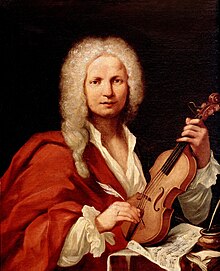
The Four Seasons is a group of four violin concerti by Italian composer Antonio Vivaldi, each of which gives musical expression to a season of the year. These were composed around 1718–1720, when Vivaldi was the court chapel master in Mantua. They were published in 1725 in Amsterdam, together with eight additional concerti, as Il cimento dell'armonia e dell'inventione.

The Mandolin Concerto in C major, RV 425, was written by the Italian composer Antonio Vivaldi in 1725.

L'estro armonico, Op. 3, is a set of 12 concertos for string instruments by Italian composer Antonio Vivaldi, first published in Amsterdam in 1711. Vivaldi's Twelve Trio Sonatas, Op. 1, and Twelve Violin Sonatas, Op. 2, only contained sonatas, thus L'estro armonico was his first collection of concertos appearing in print. It was also the first time he chose a foreign publisher, Estienne Roger, instead of an Italian. Each concerto was printed in eight parts: four violins, two violas, cello and continuo. The continuo part was printed as a figured bass for violone and harpsichord.
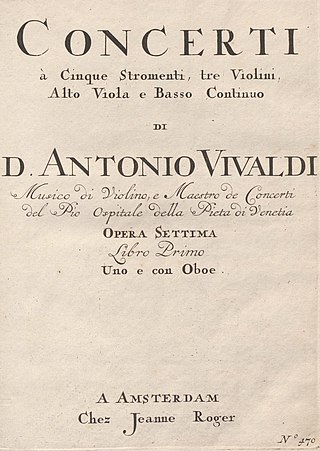
A set of twelve concertos was published by Estienne Roger in 1716-1717 under Antonio Vivaldi's name, as his Opus 7. They were in two volumes, each containing concertos numbered 1-6. Of the set, ten were for violin solo; the other two were for oboe solo. The authenticity of some of the works included has long been doubted by scholars. Three are now considered spurious for stylistic reasons. They are: No. 1 in B-flat major for oboe, RV Anh. 143 ; No. 7 in B-flat major for oboe, RV Anh. 142 ; and No. 9 in B-flat major for violin, RV Anh. 153.

La stravaganza [literally 'Extravagance'], Op. 4, is a set of concertos written by Antonio Vivaldi in 1712–1713. The set was first published in 1716 in Amsterdam and was dedicated to Venetian nobleman Vettor Delfino, who had been a violin student of Vivaldi's. All of the concertos are scored for solo violin, strings, and basso continuo; however, some movements require extra soloists.
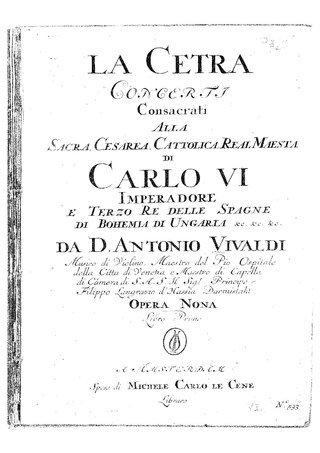
La cetra, Op. 9, is a set of twelve violin concertos by Antonio Vivaldi, published in 1727. All of them are for violin solo, strings, and basso continuo, except No. 9 in B flat, which features two solo violins. The set was named after the cetra, a lyre-like instrument, and was dedicated to Emperor Charles VI.
An organ concerto is an orchestral piece of music in which a pipe organ soloist is accompanied by an an orchestra, although some works exist with the name "concerto" which are for organ alone.
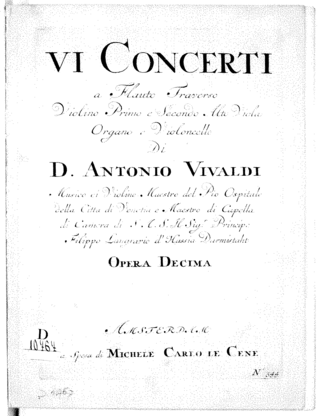
Antonio Vivaldi wrote a set of flute concertos, Op. 10, that were published c. 1728 by Amsterdam publisher Michel-Charles Le Cène.
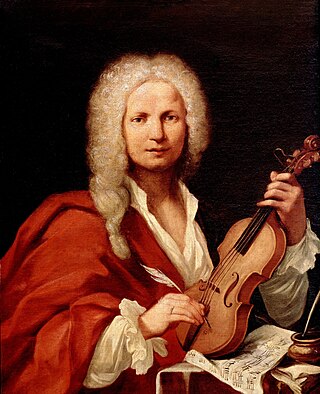
Antonio Vivaldi wrote a set of concerti, Op. 11, in 1729.

Antonio Vivaldi composed several sonatas for cello and continuo. A set of six cello sonatas, written between 1720 and 1730, was published in Paris in 1740. He wrote at least four other cello sonatas, with two manuscripts kept in Naples, another in Wiesentheid, and one known to be lost.

The Lute Concerto in D major, RV 93, is one of four works featuring the solo lute, 2 violins, and basso continuo written by Antonio Vivaldi. Vivaldi wrote the piece in 1730-1731, a period in which he wrote two of his other works featuring the lute: the trios for violin and lute in G minor and C major.

Hooked on Classics 2: Can't Stop the Classics is an album by Louis Clark and the Royal Philharmonic Orchestra, published in 1982 by K-tel, part of the Hooked on Classics series.

La tempesta di mare, a flute concerto in F major, is the first of Six Flute Concertos, Op. 10 by Antonio Vivaldi, published in the late 1720s. La tempesta di mare may also refer to two earlier versions of the same concerto, RV 98, a concerto da camera featuring the flute, from which Vivaldi derived the concerto grosso RV 570.
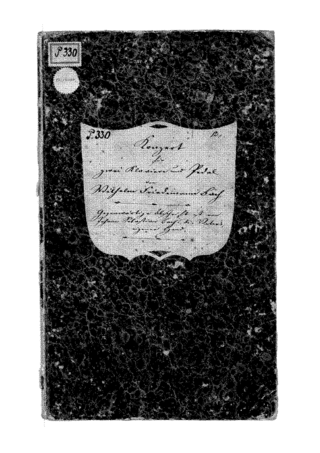
The organ concertos of Johann Sebastian Bach are solo works for organ, transcribed and reworked from instrumental concertos originally composed by Antonio Vivaldi and the musically talented Prince Johann Ernst of Saxe-Weimar. While there is no doubt about the authenticity of BWV 592–596, the sixth concerto BWV 597 is now probably considered to be spurious. Composed during Bach's second period at the court in Weimar (1708–1717), the concertos can be dated more precisely to 1713–1714.

Grosso mogul, also Il grosso mogul, or capitalised [Il] Grosso Mogul, RV 208, is a violin concerto in D major by Antonio Vivaldi. The concerto, in three movements, is an early work by the Venetian composer. Around the mid-1710s Johann Sebastian Bach transcribed the concerto for organ, BWV 594, in C major. A simplified version of the violin concerto, RV 208a, without the elaborated cadenzas that appear in manuscript versions of RV 208, and with a different middle movement, was published around 1720 in Amsterdam as concerto #11 of Vivaldi's Op. 7.
Antonio Vivaldi composed three settings of the Dixit Dominus, the Latin version of Psalm 110. They include a setting in ten movements for five soloists, double choir and orchestra, RV 594, another setting in eleven movements for five voices, five-part choir and orchestra, RV 595, and a recently discovered setting in eleven movements for five soloists, choir and orchestra, RV 807, which had been attributed to Baldassare Galuppi. Dixit Dominus, RV 594, has been regarded as one of Vivaldi's "most significant sacred works".

The Concerto in C major, RV 559, is a concerto grosso by the Italian composer Antonio Vivaldi, completed in 1740.

Antonio Vivaldi's Concerto for Two Cellos in G minor, RV 531 is a concerto for two cellos, string orchestra and basso continuo in three movements, believed to have been composed in the 1720s. It is Vivaldi's only concerto for two cellos, and begins unusually with an entry of the solo instruments alone.

Antonio Vivaldi's Concerto for Two Trumpets in C major, RV 537, is a concerto for two trumpets, string orchestra and basso continuo in three movements, believed to have been composed in the 1720s. It is Vivaldi's only trumpet concerto. It was published by Ricordi in 1950 after its manuscript was found in a Turin library.
